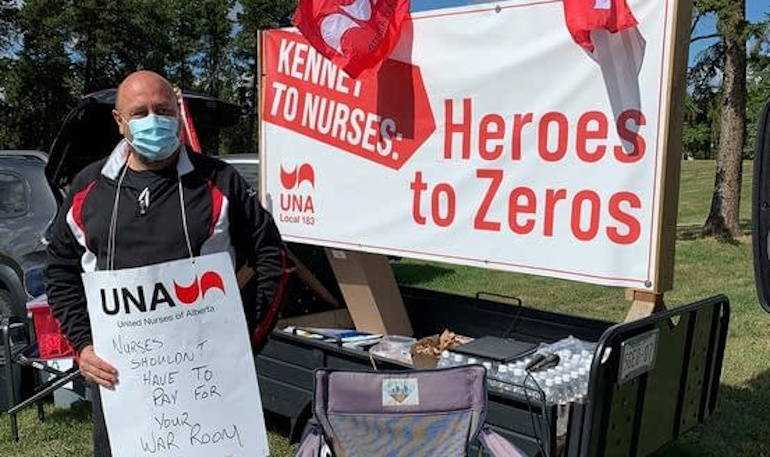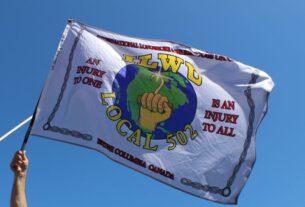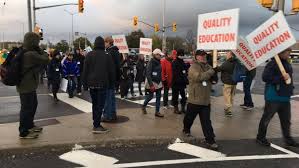Hospitals in Alberta are experiencing unprecedented demand for intensive care. During the week of September 12 to 18, the average number of COVID-19 intensive care unit admissions has been over 23 per day. Alberta has 10 percent of Canada’s population, but nearly half of all active COVID cases, with Albertans dying at more than three times the national average. The province is on track to trigger its critical care triage protocol, with ICU capacity hitting 89 percent on September 23. The Critical Care Triage Framework would be used to determine which patients will receive critical care once 90 percent capacity is reached. In that instance, only patients with more than a 20 percent chance of surviving the next 12 months would be admitted to ICUs; care could also be discontinued for some patients as the crisis worsens.
This unprecedented healthcare crisis was the result of Jason Kenney and the UCP’s termination of COVID restrictions during the summer months, when they promised Albertans would have the “Best Summer Ever.” As the situation took a turn for the worse, Kenney himself was nowhere to be found as he took an extended vacation through August to avoid “burnout” – a luxury that healthcare workers have had to do without.
Now, military support is being deployed to help with Alberta’s inundated ICUs. It was actually healthcare unions that first called for this measure, a week beforehand.
“We’ve run out of staff and we’ve run out of options. This fourth wave of the pandemic is collapsing our healthcare system,” said Rory Gill, CUPE Alberta.
Kenney turned to a cabinet shuffle to try and draw some attention away from his poor leadership, swapping now-former Health Minister Tyler Shandro with now-former Labour Minister Jason Copping. It’s hard to see how this will be any kind of improvement – both ministers have been involved in direct attacks against labour, especially nurses and healthcare workers, from their respective posts. This shuffle will merely allow them to keep attacking workers from new angles (you’ve got to keep your ministers entertained). Furthermore, it’s not as if it was mere incompetence on the part of Shandro or even Kenney that has forced the province’s healthcare into this predicament – this is equally the consequence of an ideological war against public healthcare, unions, and workers in general.
Kenney is now facing challenges from some UCP MLAs for his construction of this crisis. Originally, his leadership wouldn’t be under review until fall 2022, but the party caucus has decided to move it up to the spring. It will be interesting to see what this means for the future of the party – could there be a split down the road? After all, the party was only welded together from the floundering Progressive Conservatives and the smaller, and further right-wing, Wildrose Party in the aftermath of the election of the first NDP government in 2015. Will Kenney survive the upcoming leadership review? Unlikely, unless he can manage to pull a rabbit out of his hat. Would a new UCP leader rescue the party in the next election? Probably not: they’ve become extremely unpopular except among a hardcore base. The NDP raised $2.7 million in the first half of 2021, double the UCP’s $1.3 million.
The old Progressive Conservative Party had it easy for decades, maintaining their rule in Alberta for 44 years. They were buoyed by markets with great oil prices, which meant loads of oil revenue for the province and resulted in good public services and low taxes for years. With the collapse of oil prices beginning in mid-2014, the PCs (led by Jim Prentice) were suddenly compelled to usher in new austerity measures and heavy taxation of working people. Of course, they would never consider increasing corporate taxes. In addition to the Wildrose splitting the vote with the PCs, these unpopular policies led to the NDP’s win in the 2015 election.
The polarization between rural/southern social-conservatives and northern progressives will continue to intensify. The federal Liberals, especially rich-boy Justin Trudeau, have helped to reignite a lot of conservative vigor and vitriol in the province – but in contrast, the many crises of Alberta’s UCP resulted in a loss of seats for the Conservative Party of Canada as some voters were turned off to the idea of conservative governments in general. There are now two Liberal and two NDP seats, instead of just one NDP seat. The far-right People’s Party of Canada, which tried to capitalize on frustrations with the Liberals and anti-mask/anti-vax movements, did not manage to capture any seats. Conservative and Liberal voters have incorrectly placed their hopes in governments that will continue to let the economy stagnate, dependent on a fossil fuel economy until at least 2050. (We have previously written about diversification as a key point of Alberta’s economic future).
Northern progressives and other urbanites are much more ready to let go of Alberta’s old oil habit, but both provincial and federal NDP parties have yet to capture their imaginations as they continue to be just a bit more radical than Liberals, with an emphasis on elections and fundraising instead of organizing with working people. The result is a lot of “strategic voting” by many voters who don’t see any other way to beat conservatives. This is a strategy with a low pay-off as federal conservatives continue to dominate the province. The main driver of a probable provincial NDP government is the UCP’s multiple failures in office. However, it could still be a close call in the next election unless rural and southern strongholds flip over. Should Alberta’s NDP win the next election, their commitment to transitioning away from oil is questionable, as they ended up playing ball with the oil barons when they were last in power.
We have seen the majority of Albertans support campaigns against coal mining in the Rockies. Further, only a small number of Albertans are truly supportive of the UCP’s war on public healthcare. It also needs to be pointed out to rural voters that the UCP and their big business buddies don’t care about anything but their private financial interests and political power. Rural municipalities are owed $245 million in unpaid taxes by oil companies, and Kenney has done nothing to help these communities, so these unpaid bills have been downloaded to rural homeowners in the form of increased taxes. There is common ground to be found between rural and urban voters, and we need a party that will organize around it.
During a legislative assembly, Kenney once derided Rachel Notley as the only one-term premier in Alberta’s history. Albertans should fight back and make sure he doesn’t even make it through his first. As Socialist Alternative has stressed, the NDP and the Alberta Federation of Labour should not wait for the 2023 election. A strong program of taxing corporations, bolstering public services, ending and reversing cuts, creating public jobs, and transitioning to clean energy (even more jobs) could be the basis of a popular campaign to drive Kenney and the UCP from office. It’s time to step up the calls for the UCP to go, with a mass movement to back it up.




